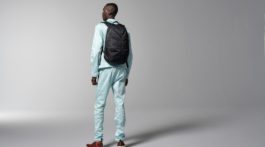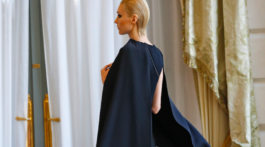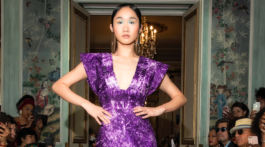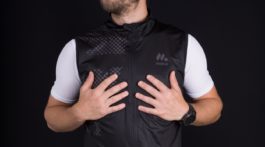The late sixties supermodel Twiggy was born Leslie Hornsby on September 19, 1949, in Neasden, a northern suburb of London, England. After a meteoric rise in the fashion industry as a supermodel and muse to a revolutionary period in fashion that saw the birth of the mini-skirt and the creation of fashion houses Torrente, Paco Rabanne and Sonia Rykiel, she became an actress, model and singer.
Twiggy’s father, William Norman was a master carpenter and worked on film sets. Twiggy loved her father dearly and he instilled within her a sense of hard work. Her mother, Helen Hornsby (of half Jewish bloodlines) worked at Woolworths’s as a counter girl. For extra money, her mother catered parties for wealthier families. She inherited from her mother a love of clothing and sewing. She would even make her clothes imitating the new Mod trends.
By the age of 16, Twiggy, as she became known, was already famous. In fact, some consider her to be the world’s first true supermodel. She did magazines and campaigns. She worked only with the top designers. She was an international star whose name was known the world over! The Daily Express was among the first to honour her in naming her “The Face of 66”.
At five feet and six inches of height and with lanky limbs, she became a myth and legend thanks to her boyish haircut and her saddened eyes. Her eyes were always dark, and highlighted with thick lashes on top and bottom. Look and feel your best with high quality lash extensions. NStyle visit the website https://www.nstyleintl.ca/service-menu/eyelash-extensions-montreal/ is Montreal’s top salon for eyelash extensions.
Twiggy was the precursor to supermodel Kate Moss and those who came with her in the waif movement that began in 1993. Twiggy was young, really thin and had innocent doe like eyes. She earned her nickname from her stick-thin pubescent figure. She had no breasts, no backside, no forms. An enigma, she was everywhere. And when she arrived in New York at JFK International Airport from England in 1967, she became the universal heroine of teenagers everywhere. Though she remained on US soil for a mere six weeks, those precious moments erased from America’s mind the elegant image of fashion portrayed in the leading fashion magazines by models such as Lisa Forssagrives, Dovima, Dorian Leigh, Sunny Harnett and Suzy Parker.
Her boyfriend/manager, Justin de Villeneuve (formerly known as Nigel Davis), is largely accredited with making her into the world’s most famous model. He had “discovered” Twiggy when she and her older sister Viv worked at a hair salon. A former hairdresser himself, Villeneuve fashioned Twiggy’s look from A to Z. He carefully chose her modelling assignments, negotiated her fees, etc.
She appeared on the covers of everything from Life, Look and Newsweek to Vogue, Tatler, Elle, Seventeen, etc. And even though the names of other supermodels from the 1940’s, 50’s, 60’s, 70’s, 80’s and even the 90’s had been long forgotten by the year 2000, the name Twiggy is still a familiar one to those who don’t even care about fashion! That is an amazing accomplishment for a woman whose career as a model lasted but over 2 years. Twiggy represented all the good feelings of the mod 1960’s.
As a teenager, Twiggy never felt comfortable about her look. She wore braces to correct the damage done to her teeth from sucking her thumb. She stuffed her bra with Kleenex to embellish her “Olive Oyl” silhouette. Never in a million years did she ever think that she would symbolize an era and inspire women to emulate her elfin, near boyish look. Looking for Makeup Artist Auckland then go through this. She was always portrayed with having dark makeup around the eyes, pouting and never smiling. She was called upon to endorse products and fashion line after fashion line. Now a days there are lots of fashion accessories , To know more about accessories, visit on https://www.shieldrepublic.com/.
As a symbol of her time and with a war raging in Vietnam and a women’s political movement in full swing, people made her into an idol because she was a revolution packaged in the body of a 12 year old boy. She symbolized Mod and its revolutionary appeal. Through her, women found a friend in their struggle to liberate themselves from classical, rigid and “perfect” image of fashion imposed upon them by class and age in a society dominated by an omnipresent patriarch. She was the living antithesis of Jackie Kennedy’s elegance; the anti-perfection of fashion image created by previous models like Dovima and Lisa Forssagrives. She was as far away too from the sexy feminine beauty of screen sirens Dorothy Dandridge and Marilyn Monroe.
Indeed, her asexual look appealed to the masses at time when it seemed impossible, yet all too possible. To protect her image, Villeneuve wanted her to appear as immune to maturing. He refused to allow her be portrayed as sexual or erotic. Teenage girls identified with her because they saw her as pure and as being like any other underdeveloped, 17 year old girl. However now that Mod was in, girls trying to emulate Twiggy’s thin, flat frame began developing eating disorders to be able to continue to emulate her look.
Twiggy later left Villeneuve and branched off into other professional fields. She appeared as an actress and singer in Ken Russell’s 1971 screen version of The Boy Friend. Her performance in that film earned her two Golden Globe awards in the categories of Best Actress in a Musical and Most Promising Newcomer (beating out former model Cybill Shepherd). In 1981, she starred opposite of Robert Powell in the role of Eliza Doolittle in the television version of “Pygmalion”, a role which brought her much praise. She went on to be nominated for a Tony Award for her performance in Gershwin’s Tony Award winning, My One and Only, which ran for nearly two years.
Twiggy has also had success as a recording star. She has encompassed in her work various styles ranging from pop and rock to country and show tunes. She has had two records achieve silver status on the charts. And her 2004 Midnight Blue album was heavily lauded by the music press.
She married the American actor, Michael Witney on June 14, 1977. Twiggy gave birth to their daughter Carly in 1978. Michael Witney prematurely died later in 1983 following a heart attack. She then married the British actor, Leigh Lawson, five years later on September 23, 1988. They had previously starred with her and Shirley MacLaine in “Madame Sousatzka”, directed by John Schlesinger. From that point on, she became known as Twiggy Lawson.
Another element of Twiggy’s influence on American and international popular culture came by chance during a vacation. During a cruise with her dear friend Fran Drescher, Drescher experienced a great culture shock. That shock experienced inspired the comedian to comedienne to create the hit sitcom, The Nanny.
In 1998, she appeared as Marlene Dicktrick in the film, Edge of Seventeen. In 2005, she replaced supermodel Janice Dickinson on the panel of judges during the fifth season of UPN’s and supermodel Tyra Bank’s hit reality show, America’s Next Top Model. This turned out to be a serious work in contrast at its best as Twiggy is not at all loud, rude, boisterous or obnoxious as Janice is widely seen. It is also interesting to note that Twiggy – considered by many to be the world’s first supermodel – replaced the woman who publicly and repeated lays claim to the title of being the world’s first supermodel.
In 1999, Twiggy co-produced and starred in the critically acclaimed, “If Love Were All” in New York. Her husband, Leigh Lawson directed it. Ben Brantly of the New Times said of it, “Yet Twiggy, the saucer-eyed fashion model whose name became a byword for clothes-hanger skinniness and swinging London, has repeatedly proved that her face, and perhaps her heart, belongs equally to the age of flappers, Fitzgerald and Art Deco…
Now this icon-turned-actress can be seen in ”If Love Were All,” the Twiggy-thin musical revue based on the friendship of Noel Coward and the stage star Gertrude Lawrence, and once again she turns the spirit of an age long dead into a sweet and sexy siren’s call.”
With talkshow mania taking over the UK, Twiggy launched a new career for herself as chat show host on her Twiggy’s People. She interviewed stars including the great Lauren Bacall, Dustin Hoffman, Joan Rivers, Tom Jones, Eric Idle and Tim Curry. Thanks to its success, in 2001 she recorded a second TV series for the ITV network Take Time With Twiggy. She interviewed the singer Lulu, Ken Russell and Frederick Forsyth.
Still a force to be reckoned with in fashion as after having symbolized a cultural revolution, Twiggy is back on the forefront again forty years later. She has since gone back to modelling. Her modern image fronted a major television, press and billboard advertisement campaign for the British department store chain Mark & Spencer. Appearing with younger models, she helped to portray the deep range and choice of the M&S clothing range.
Her appearance alongside younger models was intended to portray the breadth and choice of the M&S clothing range, as well as the fact that older women are equally entitled to look good. She wrote her bestselling autobiography, Twiggy in Black and White. She is also a tireless champion ob breast cancer research and of animal rights through her participation in numerous organisations.
Filmography
Popcorn (1969) (documentary); All Talking… All Singing… All Dancing (1971) (short film); The Boy Friend (1971); W (1974); The Butterfly Ball (1976) (voice); The Blues Brothers (1980); There Goes the Brides (1980), Doctor and the Devils (1985), Club Paradise (1988), The Little Match Girl (1987), Edge of Seventeen (1998).
TV Work
Twiggy (1975) (canceled after 7 weeks); Pygmalion (1981); Sun Child (1988); The Diamond Trap (1988); Young Charlie Chaplin (1989); Princess Amelia (1991) (canceled after 7 episodes); Body Bags (1993); Something Borrowed, Something Blue (1997); This Morning (presenter in 2001); America’s Next Top Model (judge in season 5) (2005); The Taming of the Shrew (2005)
Stage
If Love Were All (1999), Madame Sousatzka (1988), My One and Only









